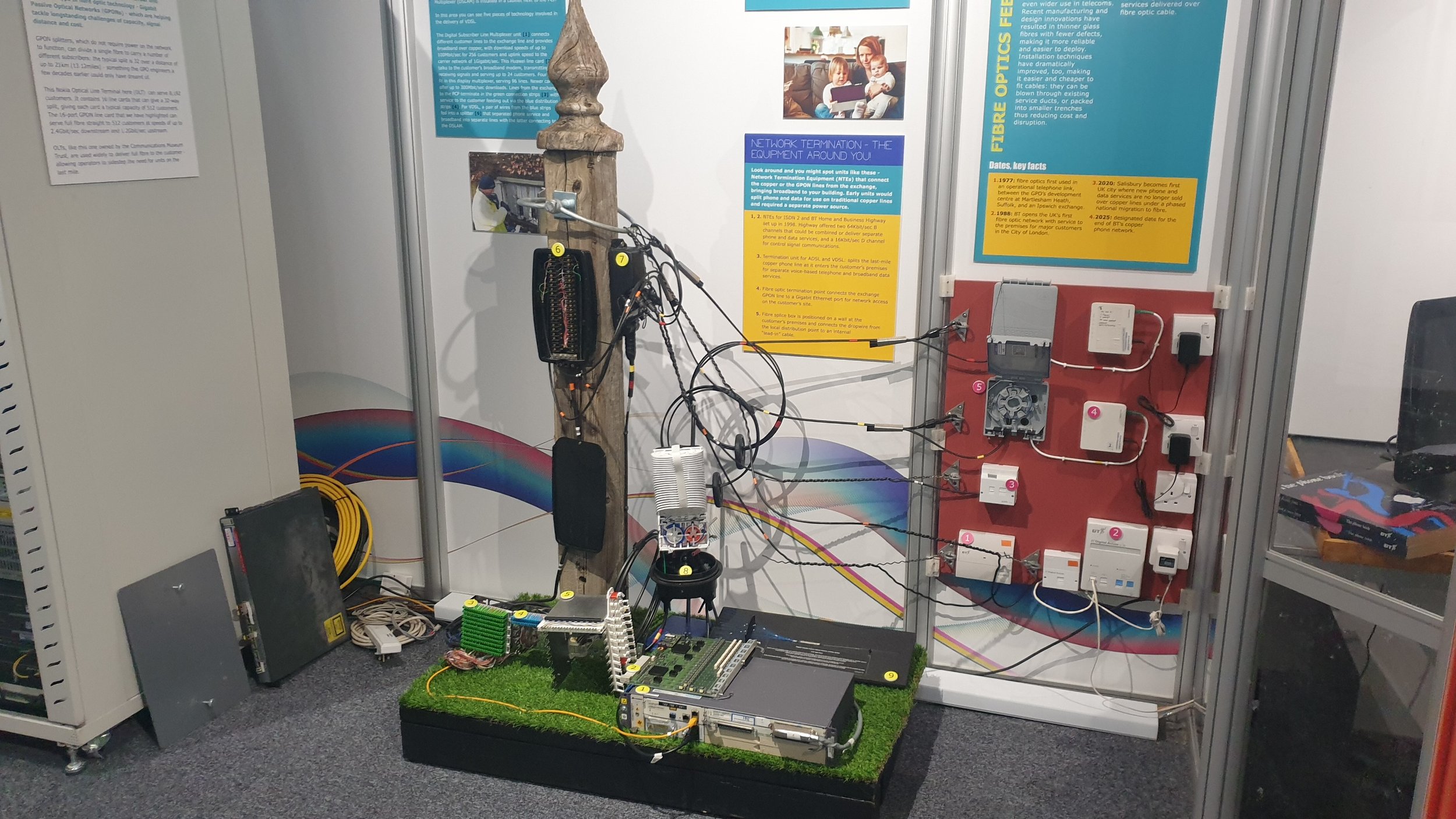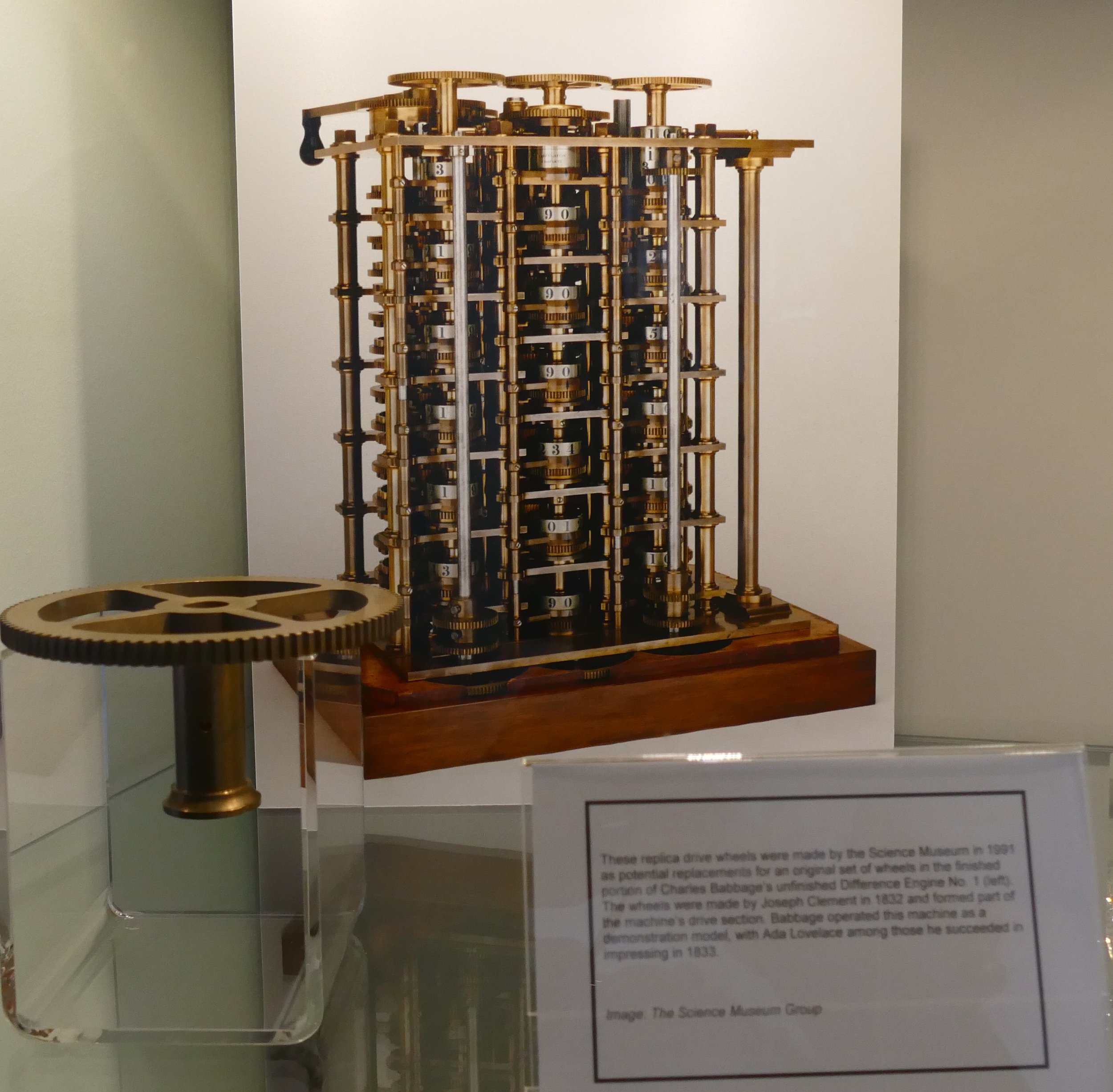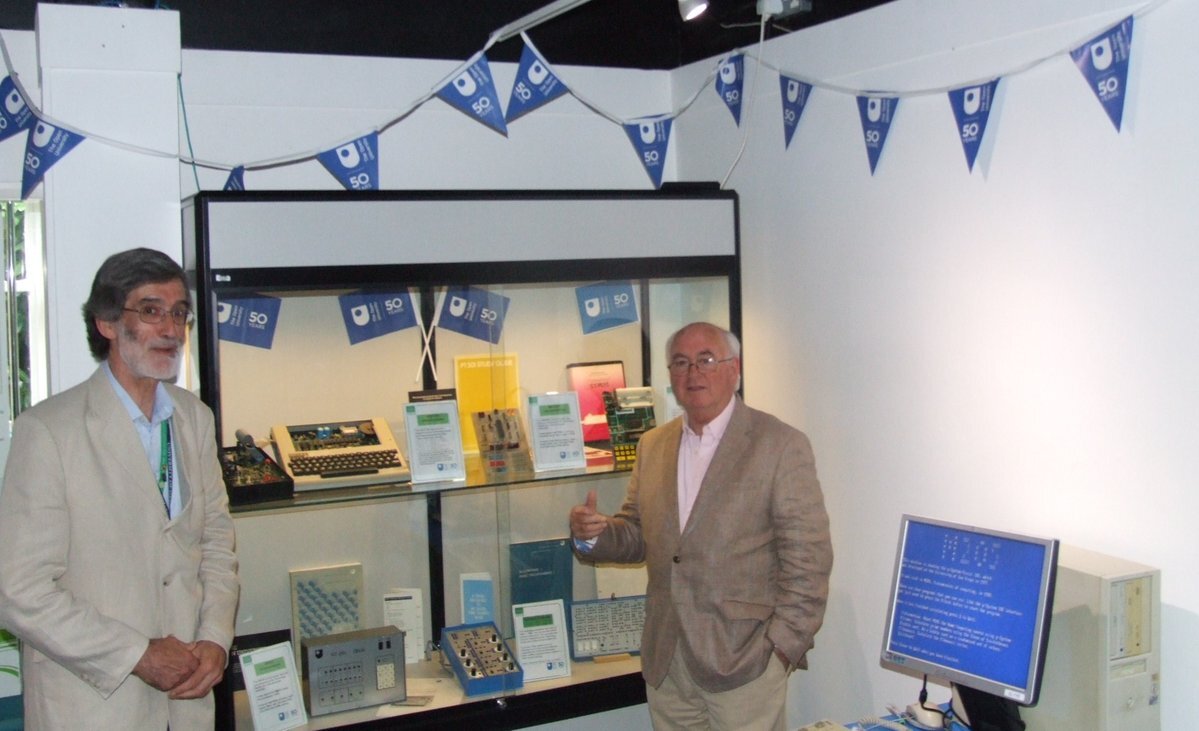Pop-Up Exhibition Space
The Pop-Up Exhibition space is where short term displays (typically 3 to 6 months) will be shown covering all aspects of computing. Details of the current display, proposed future displays and pictures of the previous displays can be seen below.
Current Display - Flowers to Fibre
Gallery Sponsored By: The Post Office Remembrance Fellowship
March 2023 to Current
The National Museum of Computing (TNMOC) and The Communications Museum Trust (CMT) are together celebrating the anniversary of the start of a journey to modernise Britain’s telephone network under the engineering genius of Tommy Flowers, the man behind Bletchley Park’s Colossus code-breaking computer, with an exciting new exhibition.
Flowers and his successors at the General Post Office (GPO) and British Telecom (BT) worked for half a century starting in 1947 to make the existing copper voice network a faster and more reliable vehicle for the digital services we enjoy today. They not only turned research into core principles of technology underpinning telecoms - including fibre – they also built the world’s first digital phone exchanges in Britain.
The joint TNMOC and CMT exhibition Flowers to Fibre takes visitors on a journey through this often overlooked story: from first pilots of the prototype digital exchanges to the planned national switch from copper to fibre after 2025. It shines a light on the stories of those involved, too.
Flowers to Fibre is a hands-on, interactive experience that includes:
A working example of early Strowger electro-mechanical telephone exchange equipment, that dominated the national phone network and visitors can use to make phone calls.
Rare examples of components from the early modern exchanges, a prototype of System X digital telephone switching system, and ADSL pilot equipment from the dawn of Britain’s broadband.
The chance to experience “dial-up internet” today with the technology of the past – a 1990s’ PC/modem.
Press material from coverage of the GPO’s very first, ground-breaking digital-exchange pilot.
The chance for those involved in development of Britain’s high-speed phone network to record their stories as part of a new TNMOC archive project.
Exhibition Gallery
Online Display - Microsoft Timeline
July 2020 to Current
It started with one idea. One Vision. A personal computer on every desk and in every home. This revolutionary idea not only made technology a powerful tool for all of us, it created a new industry that changed our world.
Today, Microsoft continues to expand the possibilities of cloud computing to empower every person and every organisation on the planet to achieve more.
This exhibition is currently online only and shows a timeline of Microsoft’s History covering people, major events and releases from its inception in 1975 to the present day.
Past Display - Charles Babbage - Who do YOU think he is?
26th November 2022 to 28th December 2022
This pop-up exhibition celebrated the 200th anniversary of Charles Babbage’s announcement of the invention of the Difference Engine. As part of the gallery opening, Doron Swade, a leading authority on Babbage, gave a presentation on Babbage and described the controversies, rivalries and challenges that faced the first computer pioneer in his attempts to mechanise calculation and how he was led from this to general-purpose computing.
The exhibition shows pictures of:
Difference Engine No. 1, the first complete design for an automatic calculating machine.
The Analytical Engine, a fully-fledged programmable general-purpose digital computer that he designed when work on Difference Engine No. 1 stopped
Difference Engine No. 2, an improved version of the first.
The reconstructed Difference Engine No. 2 (which Babbage never actually finished) built by the Science Museum in 2002.
A large portrait of Babbage himself and a portrait of Ada Lovelace, who collaborated with Babbage to write the first programs for the Analytical Engine.
In the display cabinet are several pictures of reconstructions of parts of the Difference Engines in Brass/Steel and Meccano with a real model made of Lego.
“There are many misconceptions about Babbage, his motivation for the engines, and the reasons for his failure to build them. This event offers an opportunity and a platform to reveal new findings and new perspectives. Be ready to be surprised’ - Doron Swade
Exhibition Gallery
Past Display - BBC though the decades
October 2022 to 21 November 2022
This pop-up exhibition was called “BBC through the decades” to celebrate the 100th anniversary of the British Broadcasting Corporation, the pioneering and globally trusted public service broadcaster. The BBC has been at the forefront of analogue and digital technology for a century, and today the BBC reaches an average audience of 489 million adults every week. Visitors to the TNMOC exhibition will witness the evolution of the technologies that have formed the backbone of the BBC over its history and get hands-on with the technology that made the BBC famous.
The official exhibition event is on 15 October 2022 and showcases what it takes to build a globally recognised broadcaster. It’s a story of technology through the ages that begins with analogue radio broadcast technology of the 1920s and ends with BBC iPlayer and the internet-enabled platforms of today. It includes the first television broadcast in 1932, the move to colour in 1967, the launch of the BBC website in 1997, and the digital switchover that began in 2007.
Highlights of the nostalgia-filled exhibit include:
Ceefax reimagined – Ceefax, which began at the BBC in 1974, will be celebrated with a special TNMOC version of the world’s first Teletext information service
The BBC Micro, an 8-bit microcomputer which is still going strong 40 years since its launch. The museum uses several of these venerable machines in its classroom, and visitors will be able to get hands-on with retro games
A BBC Domesday Project machine from 1986. The Domesday Project was a landmark survey of the country in the 80s. TNMOC has an original machine that still runs off its original LaserDiscs.
Early radios and TVs
“TNMOC’s exhibition honours the remarkable technological evolution at the BBC across its 100-year history, and I’m overjoyed to be able to open such a fascinating celebration of how far we’ve come.” - Rory Cellan-Jones, fomer BBC correspondent.
Exhibition Gallery
Past Display - Raspberry Pi 10th Anniversary
March 2022 to September 2022
In 2012, Raspberry Pi started shipping its first computers in order to inspire young people to re imagine the role of technology in their lives. What started with a low-cost, high performance computer has grown into a movement of millions of people of all ages and backgrounds. Today, Raspberry Pi is the UK's best selling computer company, and the Raspberry Pi Foundation is one of the world's leading educational non-profits. Raspberry Pi computers make technology accessible to people and businesses all over the world. They are used everywhere from homes and schools to factories, offices and shops.
This new pop exhibition delivered by the team from Raspberry Pi, showcases the journey of the Raspberry pi and shows some of the creative projects developed by the Raspberry pi community.
Visitors have the opportunity to be inspired by the creations displayed and have a go at the Raspberry Pi activities. You can also explore the museum and see how the Raspberry Pi is being used on machines from a variety of decades and displays (clue: IRIS radar feed in the NATS gallery, Simulating the ICL 2966 George 3 operating system in the LSG. Showing various presentations on TV displays around the museum)
Eben Upton, CEO of Raspberry Pi Limited said: "I'm very proud that we can kick off Raspberry Pi's tenth birthday with an exhibition at this key historic site for computing. We're delighted to see our computer among major artefacts of British technology. I'm sure that families and young people visiting the exhibition will come away bursting with inspiration, and keen to learn about all the things they can do with computers."
Exhibition Gallery
Past Display - 1980s British Home Computing
July 2020 to February 2022
The heyday of British home computing in the 1980s is the focus of our next pop-up display.
From Sinclair ZX80s through ZX Spectrums to the BBC micro, visitors of a certain age can relive their entry into computing with hands-on access to many of the original machines. Video clips also give reminders of the landmark BBC computer literacy series that introduced so many of today’s computer programmers to the fast-developing world of computing.
You can also watch excerpts from the very popular BBC Computer Literacy Project TV programs again, presented by Ian McNaught-Davis and Fred Harris amongst others.
It also covers the ARM architecture that was designed by the team who created the BBC Micro at Acorn. This used the RISC (Reduced Instruction Set Computer) philosophy in its design, setting it apart from many of its rivals at the time and is still in use today in many smartphones and devices.
Exhibition Gallery
Past Display - Open University 50th Anniversary
June 2019 to June 2020
The pop-up exhibition about the early days of computing at the Open University (OU) curation was led by Roger Moore (left) and the gallery was opened on Friday, 27 September 2019 by Prof John Haughton (of the Open University and an Observer columnist - right).
As pioneers in distance learning education before personal computers were the norm and the internet became commonplace, the OU developed several innovative methods to enable its students to study on computers in their own homes. The exhibition offers a rare opportunity to see six of these machines. It also presents an OU timeline, a video about the OU's early computing and micro-electronics courses and an array of historic photographs of the OU's computing since its foundation in 1969.
Exhibition Gallery
Past Display - Heath-Robinson
January to May 2019
The Heath Robinson code-breaking machine was named after W Heath Robinson, the illustrator. Because of wartime secrecy, he never would have known.
Special guest Peter Higginson, great nephew of W Heath Robinson, will give a talk about Heath Robinson's interest in science and how it influenced his work and legacy.
Colossus Rebuild chief engineer Phil Hayes will talk about the Heath Robinson machine, how it inspired Colossus and what it actually did.
And there will be a temporary exhibition of eight original Heath Robinson illustrations in partnership with the Heath Robinson Museum in Pinner, London.











































































